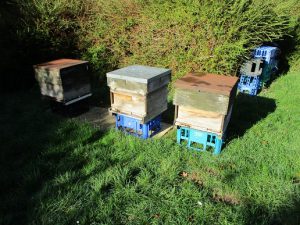All hives were prepared to be winter-fed with Apikel this year. Not all of them completely emptied their Ashforth feeders but that was simply because they were already well fed. One hive, hive 2, however took down hardly anything and that’s a bad sign; usually queenlessness.
Hive 2 therefore needed requeening and this was best done by uniting with S1; a smallish colony with a new queen.
S1 was gradually moved, 3 feet per flying day, until it stood alongside hive 2.
The two hives were then swapped over so most if not all of 2’s flying bees homed in on hive S1



It was now time for the final unite. With two small colonies it can be done quickly and easily by masking the colony aromas. I spray all the frames down with a very dilute mix of water with a drop of essential lavendre oil. On this occasion it was too risky as although I had looked through hive 2 and not found a queen, that didn’t rule out there being a virgin queen raised as a supersedure too late in the season to mate. This therefore had to be a brushing-out unite.



The bees on the ground in front of S1 will find their way in during the day but the guards wont allow in an alien queen, virgin or otherwise.
Any frames in hive 2 containing stores were put into S1 and it was job done.


